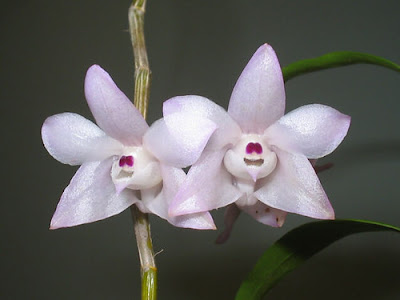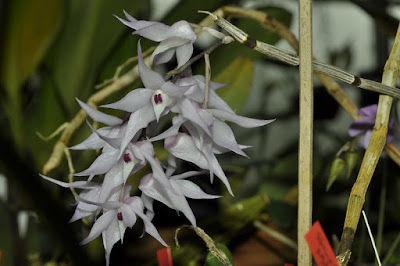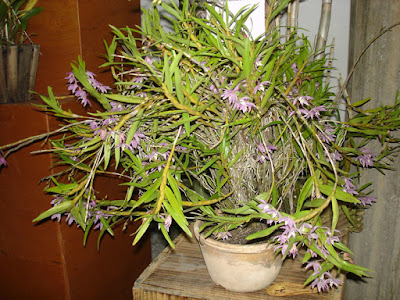Dendrobium aduncum is native to southern China (Guangdong, Guangxi, Guizhou, Hainan, Hunan, Yunnan), the eastern Himalayas (Assam, Sikkim, Arunachal Pradesh, Bhutan, Myanmar), and northern Indochina (Laos, Thailand, Vietnam). It grows in subtropical forests and broadleaf, evergreen lowland forests and primary montane forests near rivers at elevations of 300 to 1300 meters above sea level.
Dendrobium aduncum also called as The Inward-Bent Dendrobium, Callista adunc, Dendrobium aduncum var. faulhaberianum, Dendrobium faulhaberianum, Dendrobium oxyanthum, is a species of the genus Dendrobium. This species was described by John Lindley in 1842.
IDENTIFY DENDROBIUM ADUNCUM ORCHID PLANT
Dendrobium aduncum is native to southern China (Guangdong, Guangxi, Guizhou, Hainan, Hunan, Yunnan), the eastern Himalayas (Assam, Sikkim, Arunachal Pradesh, Bhutan, Myanmar), and northern Indochina (Laos, Thailand, Vietnam). It grows in subtropical forests and broadleaf, evergreen lowland forests and primary montane forests near rivers at elevations of 300 to 1300 meters above sea level.
It is a medium sized, hot to cool growing epiphytic species which reaching 50-100 cm in height with pendulous, terete, fractiflex, branching canes enveloped by sheaths and carrying 4 to 6, linear-lanceolate, acuminate, 7-10.5 x 1-3.5 cm leaves.
The Inward-Bent Dendrobium blooms on an axillary, 7cm long, zigzag, racemose inflorescence arising from the leafless nodes at the apex of an older leafless canes occuring in the spring through fall with 2 to 5, long-lasting, fragrant flowers. The flowers are spreading; sepals and petals pale pink, lip white, callus green, column white, anther cap deep purple.
DENDROBIUM ADUNCUM ORCHID PLANT CARE AND CULTURE
Cultural information should only be used as a guide, and should be to be adapted to suit you. Your physical location; where you grow your plants, how much time you have to devote to their care, and many other factors, will need to be taken into account. Only then can you decide on the cultural methods that best suit you and your plants.
Light:
Dendrobium aduncum like plenty of light (25000-50000 lux, better in bright, diffused light) but not direct sun's rays, except in the early morning. The light level should be as high as possible, which the plant can tolerate without scalding the leaves.
Temperature:
The average temperature of the summer day is 24-25 ° C, night 20 ° C, giving a daily difference of 4-5 ° C. In winter the average day temperature is 11-14 ° C, night 7-10 ° C, giving a daily difference of 4-5 ° C.
Humidity:
From summer to autumn, The Inward-Bent Dendrobium need the humidity of 80-85%, but for most of the remaining period it drops to 60-70%. Too dry air has a negative effect on the development of the plant: its growth is inhibited, and the leaves begin to turn yellow and dry out. The higher temperature, the higher the humidity should be, and the higher the humidity, the more often and longer it is necessary to ventilate the room where the plants are contained, otherwise the probability of rotting and various kinds of fungal diseases.
Substrate, growing media and repotting:
Dendrobium aduncum grows best on rafts that are formed by nailing (with copper nails) a number of short lengths of beech or hardwood horizontally across a similar number of perpendicular pieces to form a sort of lattice or grating. The raft is covered with fibre or peat with a little green sphagnum moss, the orchid being fastened thereon with copper wire.
They can also be grown in pots with staghorn peat as substrate (crocks and charcoal at the bottom ot the pot). After potting, keep the plant in a cool, shady place for a few days before placing it in its growing position. Do not overpot. Use the smallest pot that will accommodate your plant.
It does not need frequent repot, therefore, it is desirable to transplant only when it is really necessary, for example, in cases of strong salinization or compaction of the substrate, at its critically high or low pH (the norm is from 5.5 to 6.5) or when the plant grows very strongly and the pot becomes cramped to it (pseudobulbs begin to hang from the edges of the pot). Repotting is best done immediately after flowering when new roots and new growth begin to grow.
Watering:
The Inward-Bent Dendrobium will require heavy watering until well into the Autumn, the plants then being allowed to dry out for the Winter, except for a soaking about once in four to six weeks. Watering is directly dependent on the temperature of the content, the higher it is, the more often it needs to be watered. When watering, excess water should flow freely from the pot, since stagnation of water both inside the pot and in its pan can very quickly lead to rotting of the roots and the lower part of the plant.
Fertilizer:
It is recommended to use a 1/4-1/2 dose of orchid fertilizer weekly. You can use the balanced fertilizer throughout the year or from spring to mid-summer use high-nitrogen fertilizer, and then until the end of autumn high-phosphoric fertilizer to stimulate flowering.
Rest period:
Dendrobium aduncum have a short 3 to 4 week rest period in winter. They need less water in this period, especially if they grow under the conditions of a dark, short day that occurs at moderate latitudes. They should dry somewhat between waterings, but they should not be dry for a longer period. Frequent morning fogging and rare, economical watering should allow the plant to go through a dry period of rest, while providing it with sufficient humidity. Fertilization should be reduced or eliminated until new growths appear and a more abundant spring watering begins.















How much a dendrobium aduncum would cost?
ReplyDelete